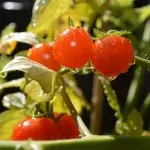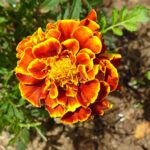Growing Tomatoes: An Essential Guide for a Bountiful Harvest
Tomatoes are one of my favourite plants to grow, as their versatile and tasty flavours enhance my homemade dishes. Particularly, I enjoy using my homegrown tomatoes to create fresh, flavorful pizza or pasta sauces, adding a personal touch to my culinary creations. Whether you’re an experienced or beginner gardener, growing tomatoes is a rewarding and enjoyable activity. With various flavours, colours, and sizes, tomatoes offer endless possibilities for your culinary creations. In this comprehensive guide, you will learn how to grow tomatoes, from planting seeds to staking the plants, and explore the benefits of companion planting. We’ll cover essential tips on how to grow tomatoes in pots, how to plant tomatoes, and how to stake tomatoes for a bountiful harvest.
Types of Tomatoes
There are two main categories of tomatoes based on their growth habits: determinate and indeterminate.
- Determinate tomatoes: These plants have a bush-like growth habit and typically grow to a predetermined height, usually around 3-4 feet. They produce most of their fruit within a short period, making them ideal for gardeners who want a large harvest all at once for canning or preserving.
- Indeterminate tomatoes: These plants have a vining growth habit and can continue growing until frost kills them. They produce fruit throughout the growing season, providing a steady supply of fresh tomatoes for the table.
Tomato Varieties

Plum Tomatoes
- Roma Tomatoes: Popular among home gardeners for their high yield. It produces oblong-shaped tomatoes with a firm texture and sweet, low-acid flavour. Roma is one of my favourites for making sauces and pastes. It’s easy to grow indoors or outdoors.
Slicing Tomatoes
- Beefsteak Tomatoes: Large and meaty, with a rich, sweet flavour, ideal for slicing and enjoyed in sandwiches or salads.
Beefsteak Tomatoes - Black Krim Tomatoes: A unique heirloom variety with a dark, purplish-red colour and sweet, smoky flavour, medium to large, and known for their rich taste and unusual appearance.
- Cherokee Purple Tomatoes: An heirloom variety with a distinctive deep purple colour, medium to large size, and a rich, smoky flavour that features a slightly sweet taste with a tangy finish.
- Brandywine Tomatoes: A popular heirloom variety known for their large size, sweet flavour, and juicy texture, often weighing up to a pound each, with a unique taste and slightly flattened shape.
Cherry Tomatoes

- Sweetie Tomatoes: A small cherry tomato variety with a sweet flavour, firm texture, and deep red colour, often used for snacking or in salads; easy to grow both indoors and outdoors with minimal maintenance.
- Black Cherry Tomatoes: A distinctive cherry tomato variety with a rich, complex flavour and deep purple-black colour, small in size, perfect for salads or snacking, and easy to grow both indoors and outdoors with consistent watering and regular pruning.
How to Grow Tomatoes from Seed
Starting tomatoes from seeds provides gardeners with access to a wider range of tomato varieties and can save money in the long run. Here’s how to grow tomatoes from seeds:
- Sow seeds indoors: Start tomato seeds indoors 6 to 8 weeks before your area’s last expected frost date. Use a seed-starting mix and sow seeds about 1/4 inch deep in seed trays or small pots.
- Provide warmth and light: Place the seed trays or pots in a warm location, ideally between 70°F and 80°F. Once the seeds have germinated, move the seedlings to a sunny spot or use grow lights to provide at least 12 hours of light per day.
- Transplant seedlings: After the last frost has passed and the soil has warmed, transplant your tomato seedlings outdoors. Plant them deeper than they were in their pots, burying the stem up to the first set of true leaves. This will encourage the development of a strong root system.
Planting Tomatoes
Planting tomatoes properly is crucial for growing tomatoes successfully. Follow these steps to plant your tomatoes:
- Choose a sunny location: Tomatoes require at least 6 to 8 hours of direct sunlight daily for optimal growth and fruit production.
- Prepare the soil: Tomatoes prefer well-draining, fertile soil with a pH between 6.0 and 6.8. Add compost or aged manure to the planting site to improve soil fertility.
- Space the plants: Proper spacing is essential for good air circulation and to reduce the risk of diseases. Space determinate tomato plants about 2 feet apart and indeterminate plants 3 to 4 feet apart. Rows should be spaced 4 to 5 feet apart.
- Plant deeply: When transplanting tomato seedlings, bury the stem up to the first set of true leaves to encourage a strong root system.
How to Grow Tomatoes in Pots
Growing tomatoes in pots is an excellent option for gardeners with limited space or who want to grow tomatoes on a balcony or patio. Choose a suitable container: Select a container at least 18 inches in diameter with drainage holes. Larger pots are better for indeterminate tomato varieties, while smaller pots can be used for determinate varieties.
- Use high-quality potting mix: Fill your container with a well-draining, nutrient-rich potting mix. Avoid using garden soil, as it may compact and inhibit proper drainage.
- Plant the tomatoes: Plant one plant per pot, burying the stem to the first set of true leaves to encourage a strong root system. If you’re growing a determinate variety, you may be able to plant two plants in a larger container, but be sure to provide adequate spacing.
- Provide support: Stake or cage your tomato plants to ensure they have the necessary support as they grow. This is especially important for indeterminate varieties, which can become quite tall.
- Water and fertilize: Tomatoes grown in pots require consistent watering and regular feeding with a balanced fertilizer. Be sure to water the plants deeply and consistently to avoid common problems like blossom end rot.
Staking Tomatoes
Staking tomato plants is essential for a healthy and productive garden. Here’s how to stake tomatoes and provide the necessary support:
- Stakes: Use wooden or bamboo stakes at least 6 feet tall for indeterminate tomato plants. Drive the stake into the ground about 12 inches deep and 4 inches from the plant’s base. Tie the tomato plant loosely to the stake using soft twine or strips of fabric, allowing room for growth.
- Cages: Tomato cages are an alternative to staking and offer additional plant support. Choose a cage at least 4 feet tall for determinate tomatoes and 6 feet tall for indeterminate varieties. Place the cage over the tomato plant, ensuring it is firmly anchored in the ground.
- Trellises: Another option for supporting indeterminate tomato plants is using a trellis. This can be as simple as a wooden lattice or as elaborate as a custom-built structure. Train your tomato plants to grow up the trellis by gently weaving the main stem through the openings as it grows.
Fertilizing Tomatoes
Tomatoes are a staple in many households and gardens, but you must ensure they are properly fertilized to get the most out of your plants. The proper nutrients will help your tomato plants grow strong, produce healthy foliage, and, most importantly, yield a bountiful harvest. Here are some tips on fertilizing tomatoes for optimal growth and productivity.
When to Fertilize Tomatoes
It’s best to start fertilizing your tomato plants when they are about 6 inches tall and continue until they start to flower. Then, you can reduce the frequency of fertilization until it’s time to stop altogether, which is usually when the tomato fruits start to mature.
What Fertilizer to Use for Tomatoes
There are many types of fertilizers available, but for tomatoes, it’s best to use a balanced fertilizer with equal amounts of nitrogen (N), phosphorus (P), and potassium (K). Look for a fertilizer with an NPK ratio of 10-10-10 or similar. Alternatively, you can also use a tomato-specific fertilizer specifically formulated to meet the needs of tomato plants.
How to Fertilize Tomatoes
When fertilizing tomatoes, it’s important to follow the fertilizer packaging instructions and not over-fertilize, as this can lead to stunted growth and reduced yields. Here are the steps to follow:
- Water your tomato plants thoroughly before fertilizing.
- Apply the fertilizer evenly around the base of the plant, avoiding the stem.
- Gently work the fertilizer into the soil, careful not to damage the roots.
- Water the plants again to help the fertilizer absorb into the soil.
By following these steps and fertilizing tomatoes at the right time, you’ll be on your way to a thriving and productive tomato harvest.
Tips on How to Grow Tomatoes
To ensure a successful tomato harvest, follow these essential tips on how to grow tomatoes:
- Water consistently: Tomatoes require consistent and deep watering, especially during fruit production. Aim for about 1 to 2 inches of water per week through rainfall or supplemental irrigation.
- Mulch: Apply a layer of organic mulch, such as straw or shredded leaves, around the base of your tomato plants. This helps retain soil moisture, suppress weeds, and regulate soil temperature.
- Prune: Prune indeterminate tomato plants by removing suckers, the small shoots that grow between the main stem and the branches. This promotes better air circulation and directs the plant’s energy towards fruit production.
- Rotate crops: Practice crop rotation by not planting tomatoes in the same spot for at least three years. This helps reduce the risk of soil-borne diseases.
- Monitor for pests and diseases: Keep an eye on your tomato plants for common pests, like aphids and hornworms, and diseases like blight and wilt. Take appropriate control measures when necessary to protect your plants and ensure a healthy harvest.
Tomato Companion Plants
Companion planting is the practice of growing certain plants together to help them thrive, protect each other from pests and diseases, and improve soil health. Growing tomatoes in the garden can be enhanced by practicing companion planting, which can help repel pests and improve soil fertility. Here are some of the best companion plants for tomatoes and ones to avoid.
Companion Plants

- Basil: Basil is a great companion plant for tomatoes because it repels pests like whiteflies and mosquitoes and attracts bees and other pollinators. Plant basil around the base of your tomato plants to improve their growth and flavour.
- Marigolds: Marigolds are another excellent companion plant for tomatoes because they repel nematodes and other soil-borne pests. Plant marigolds around the base of your tomato plants to keep the soil healthy and pest-free.
- Nasturtiums: Nasturtiums are a great companion plant for tomatoes because they repel aphids and other pests. Plant nasturtiums near your tomato plants to
French Marigold protect them from pests and add a pop of colour to your garden.
- Borage: Borage is a great companion plant for tomatoes because it attracts bees and other pollinators and repels tomato hornworms. Plant borage near your tomato plants to improve their growth and yield.
- Carrots: Carrots are a great companion plant for tomatoes because they improve soil health and attract beneficial insects. Plant carrots near your tomato plants to improve the soil and protect them from pests.
Plants to Avoid
- Fennel: Fennel is a plant that should be avoided when planting tomatoes because it can inhibit their growth and yield. Fennel secretes chemicals that can be toxic to tomato plants, so it’s best to keep them separate.
- Brassicas: Brassicas like broccoli, cauliflower, and cabbage should also be avoided when planting tomatoes. These plants can attract pests like aphids and whiteflies, damaging tomato plants.
- Nightshades: Other nightshade family members, like peppers and eggplants, should be avoided when planting tomatoes. These plants can attract the same pests and diseases as tomatoes, leading to a greater risk of infection.
Companion planting is a great way to improve the health and yield of your tomato plants and add diversity and colour to your garden. By planting companion plants like basil, marigolds, nasturtiums, borage, and carrots, you can protect your tomato plants from pests and disease, attract beneficial insects, and improve soil health. Avoid planting plants like fennel, brassicas, and nightshades with your tomatoes, as they can hinder their growth and yield.
Conclusion
Learning how to grow tomatoes is a rewarding and satisfying experience for gardeners of all levels. Whether planting tomatoes in your backyard or in pots on your balcony, following the steps outlined in this comprehensive guide will help you achieve a bountiful harvest of juicy, flavorful tomatoes. From choosing suitable tomato varieties and planting seeds to proper care, staking, and companion planting, each step is essential for a successful tomato-growing experience. Remember to practice proper watering, mulching, pruning, and pest control techniques to ensure your tomato plants thrive. With dedication and patience, you’ll be enjoying your own delicious, homegrown tomatoes in no time!








Very informative, finally understood about lateral stems and suckers that need to be removed so the plant produces more fruit.
question: how do you get the seeds from the tomato?
Hi Mark,
It’s fairly easy, you just slice a tomato in half and scoop out all the little pockets where the sees are. After that you have to soak tomato seeds in water for 1 to 2 days; this is to remove the gelatinous sac that surrounds each seed. When that is done, you can rinse the seeds thoroughly by using a fine sieve or permanent coffee filter. Then spread the seeds on a plate or a sheet of paper and allow to completely air dry. It might take a week or so.
Hope this helps!